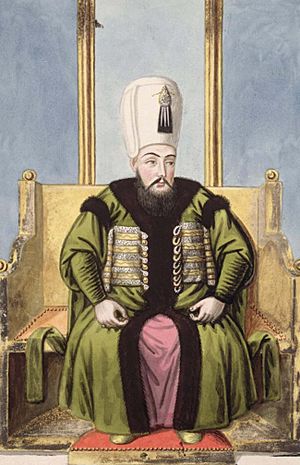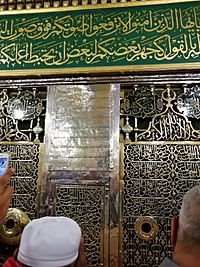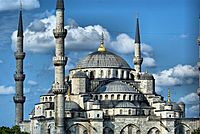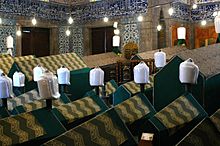Ahmed I facts for kids
Quick facts for kids Ahmed Iاحمد اول |
|||||
|---|---|---|---|---|---|
| Ottoman Caliph Amir al-Mu'minin Kayser-i Rûm Custodian of the Two Holy Mosques |
|||||

Portrait by John Young, c. 1815
|
|||||
| Sultan of the Ottoman Empire (Padishah) | |||||
| Reign | 22 December 1603 – 22 November 1617 | ||||
| Sword girding | 23 December 1603 | ||||
| Predecessor | Mehmed III | ||||
| Successor | Mustafa I | ||||
| Born | 18 April 1590 Manisa Palace, Manisa, Ottoman Empire |
||||
| Died | 22 November 1617 (aged 27) Topkapı Palace, Constantinople, Ottoman Empire |
||||
| Burial | Sultan Ahmed Mosque, Istanbul, Turkey | ||||
| Consorts | Kösem Sultan Mahfiruz Hatun Other unknown concubines |
||||
| Issue | Osman II Murad IV Ibrahim I Others |
||||
|
|||||
| Dynasty | Ottoman | ||||
| Father | Mehmed III | ||||
| Mother | Handan Sultan | ||||
| Religion | Sunni Islam | ||||
| Tughra |  |
||||
Ahmed I (Ottoman Turkish: احمد اول Aḥmed-i evvel; Turkish: I. Ahmed; 18 April 1590 – 22 November 1617) was an Ottoman Sultan who ruled from 1603 until his death in 1617. He became sultan when he was just 13 years old.
Ahmed I is famous for building the beautiful Sultan Ahmed Mosque, also known as the Blue Mosque, in Istanbul. He also changed an old Ottoman tradition: he was the first sultan who did not execute his brothers when he took the throne. This was a big change for the royal family.
Contents
Early Life of Sultan Ahmed I
Ahmed was born on April 18, 1590, in Manisa, a city in the Ottoman Empire. His father, Mehmed III, was a prince and governor at the time. Ahmed's mother was Handan Sultan.
In 1595, Ahmed's grandfather, Murad III, died. His father, Mehmed, then became the new Sultan. Sadly, Sultan Mehmed III ordered the execution of his nineteen half-brothers. Ahmed's older brother, Şehzade Mahmud, was also executed by their father in 1603, shortly before Mehmed's own death.
Ahmed I's Reign as Sultan
Ahmed became Sultan in 1603 when he was only thirteen years old. His powerful grandmother, Safiye Sultan, was still alive. There was a power struggle in the royal palace between his mother, Handan Sultan, and his grandmother, Safiye Sultan. With Ahmed's support, his mother won this struggle.
Ahmed made a big change by not executing his brother, Mustafa I. This was different from the old Ottoman tradition. Instead, Mustafa was sent to live in an old palace with their grandmother. This decision was likely because Ahmed was very young and didn't have any children yet. If Mustafa had been executed, there might not have been another heir to the throne, which could have put the royal family in danger.
Wars and Treaties
Early in his rule, Ahmed I showed strength, but the wars against Hungary and the Persian Empire did not go well for the Ottomans.
The Treaty of Sitvatorok, signed in 1606, was a setback. It ended the yearly payment that Austria had to make to the Ottomans. This showed that the Ottoman Empire was no longer growing as much in Europe.
Later, in the Ottoman–Safavid War (1603–18) against the Safavid Empire, led by Shah Abbas the Great, the Ottomans suffered a big defeat. They had to give back lands like Georgia and Azerbaijan to Persia in the Treaty of Nasuh Pasha in 1612. The new borders were set back to how they were in 1555.
War with the Habsburgs: 1604–06
The Long Turkish War against the Habsburg monarchy had been going on for over ten years when Ahmed became Sultan. The Ottoman army, led by Grand Vizier Sokolluzade Lala Mehmed Pasha, managed to recapture some cities like Pest and Vác. They also captured Esztergom in 1605.
However, internal problems like the Jelali revolts (rebellions) in Anatolia and defeats on the eastern front made the Ottomans seek peace. The Peace of Zsitvatorok was signed, which ended the yearly payment from Austria and treated the Habsburg emperor as an equal to the Ottoman Sultan. This treaty marked the end of the Ottoman Empire's expansion in Europe.
Jelali Revolts
During Ahmed I's reign, the Jelali revolts became very strong. These were rebellions by local leaders and soldiers who were unhappy with the wars and heavy taxes.
One rebel leader, Tavil Ahmed, defeated Ottoman armies. Another, Canbulatoğlu Ali Pasha, took control of the Adana area and even made his own coins. The Grand Vizier, Boşnak Dervish Mehmed Pasha, was executed for not handling the rebels well.
Kuyucu Murad Pasha was appointed to deal with the revolts. He managed to defeat a large rebel army in Syria in 1607. He also tried to make peace with some rebels in Anatolia by offering them positions. However, some continued to rebel and were eventually defeated.
Because of these widespread revolts, many villages were destroyed, and people fled their homes. Sultan Ahmed I issued a letter in 1609 to protect the rights of villagers and worked to help people resettle in abandoned areas.
Peace with Persia and its End
The new Grand Vizier, Nasuh Pasha, wanted peace with the Safavids. The Safavid Shah also agreed to a peace treaty, promising to send 200 loads of silk to Constantinople every year. The Treaty of Nasuh Pasha was signed in 1612. It gave back all the lands the Ottomans had gained in a previous war to Persia and returned to the 1555 borders.
However, this peace ended in 1615 when the Shah stopped sending the silk. The Ottomans then prepared for another attack on Persia. The war continued with more battles and changes in leadership.
Trade Agreements
Sultan Ahmed I renewed trade agreements with England, France, and Venice. In 1612, the first trade treaty with the Dutch Republic was signed. He also expanded special trade rights for France, allowing merchants from other European countries to trade under the French flag.
Architect and Service to Islam
Sultan Ahmed I is most famous for building the magnificent Sultan Ahmed Mosque, also known as the Blue Mosque. It is considered a masterpiece of Ottoman architecture and stands across from the Hagia Sophia in Istanbul. The Sultan himself helped start the construction with a golden pickaxe.
There was a small issue when it was discovered that the Blue Mosque had the same number of minarets (towers) as the Grand Mosque in Mecca, which is a very holy site. Ahmed was upset, but the religious leader suggested adding another minaret to the Grand Mosque in Mecca, which solved the problem.
Ahmed also helped with the renovation of the Kaaba in Mecca, which had been damaged by flooding. He sent skilled craftsmen from Istanbul to fix it. A new golden rain gutter was placed on the Kaaba's roof. He also had an iron net placed inside the Zamzam Well in Mecca to prevent people from jumping in.
In Medina, the city of the Islamic prophet Muhammad, Sultan Ahmed sent a new pulpit made of white marble for the mosque. He also built two other mosques in Uskudar, on the Asian side of Istanbul, though they no longer exist.
Sultan Ahmed showed great respect for Prophet Muhammad. He had a crest carved with Muhammad's footprint, which he would wear on special days. He even wrote a poem about it:
“If only could I bear over my head like my turban forever thee, If only I could carry it all the time with me, on my head like a crown, the Footprint of the Prophet Muhammad, which has a beautiful complexion, Ahmed, go on, rub your face on the feet of that rose.“
Character and Interests
Sultan Ahmed was known for his skills in fencing, poetry, and horseback riding. He could also speak several languages.
He was a poet who wrote many works under the name Bahti. Ahmed supported scholars, calligraphers (people who write beautifully), and religious men. He ordered a book called The Quintessence of Histories to be created by calligraphers. He also tried to make sure people followed Islamic laws, like attending Friday prayers and giving to the poor.
Death of Ahmed I
Ahmed I died from typhus and stomach bleeding on November 22, 1617, at the Topkapı Palace in Istanbul. He was buried in a mausoleum near the Sultan Ahmed Mosque.
His younger half-brother, Mustafa I, became the next Sultan. Later, three of Ahmed's own sons also became Sultans: Osman II (ruled 1618–22), Murad IV (ruled 1623–40), and Ibrahim (ruled 1640–48).
Family
Ahmed I had two known main consorts (wives/partners) and several other unknown ones.
Consorts
- Mahpeyker Kösem Sultan: She was his favorite and likely his legal wife. She was the mother of many of his children.
- Hatice Mahfiruz Hatun: She was his first consort and the mother of his first son, Osman II.
Sons
Ahmed I had at least thirteen sons, including three who later became Sultans:
- Osman II (1604–1622) – with Mahfiruz Hatun. He became the 16th Sultan.
- Şehzade Mehmed (1605–1621) – most likely with Kösem Sultan.
- Murad IV (1612–1640) – with Kösem Sultan. He became the 17th Sultan.
- Şehzade Bayezid (1612–1635)
- Şehzade Süleyman (1613?–1635)
- Şehzade Kasım (1614–1638) – with Kösem Sultan.
- Ibrahim I (1615–1648) – with Kösem Sultan. He became the 18th Sultan.
- Other sons: Şehzade Orhan, Şehzade Cihangir, Şehzade Selim (two different sons with this name), Şehzade Hasan, Şehzade Hüseyin.
Daughters
Ahmed I had at least ten daughters:
- Ayşe Sultan (1605 or 1608–1657) – with Kösem Sultan.
- Fatma Sultan (1606–1667) – with Kösem Sultan.
- Gevherhan Sultan (1605 or 1608–c. 1660) – with Kösem Sultan.
- Hanzade Sultan (1609–1650) – with Kösem Sultan.
- Burnaz Atike Sultan (c. 1614/1616?–1674) – possibly with Kösem Sultan.
- Other daughters: Hatice Sultan, Esma Sultan, Zahide Sultan, Zeynep Sultan, Abide Sultan.
Legacy
Today, Ahmed I is mostly remembered for building the Sultan Ahmed Mosque, also known as the Blue Mosque. This mosque is one of the most beautiful examples of Islamic architecture. The area around the mosque in Istanbul is now called Sultanahmet, named after him. He is buried in a special tomb outside the mosque's walls.
See Also
 In Spanish: Ahmed I para niños
In Spanish: Ahmed I para niños
- Transformation of the Ottoman Empire
- Abbas I's Kakhetian and Kartlian campaigns
Images for kids
-
Bilingual Franco-Turkish translation of the 1604 Franco-Ottoman Capitulations between Ahmed I and Henry IV of France, published by François Savary de Brèves in 1615






